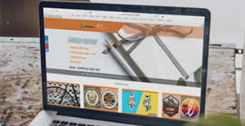How to Choose the Right Backing for Your Custom Patches?
8 Custom Patches Backings: How to Select?
Iron-On, Velcro, Adhesive, oh my! There are too many backing options when you are customizing your own custom patches. We want to make sure you can fully understand each of the backing options we offer. Each backing represents a different purpose and you will need to determine if you want a permanent backing or a temporary backing. Here is GS-JJ, We will tell you how to choose your right backing, You can see more about custom patches and get your quote.
BACKING OPTIONS

No Backing
Patches without backings are not as thick or stiff as those with backings. Therefore, patches without backings are best used for sewing onto clothing or other types of fabric.
Advantages: The most flexible option for sewing. No risk of adhesive or heat damage. Ideal for intricate or custom stitching.
Disadvantages: Thin thickness. Requires sewing skills or professional application.
Best uses: All fabrics, best for permanent applications on uniforms, hats, and other frequently used items. Suitable for use on objects that are frequently washed.

Plastic Backing
Plastic backings provide firm support for your patch, increasing the rigidity of the patch and it will maintain its shape even after long-term use.
Advantages: Provides patches with rigidity and stiffness, making them less prone to deformation.
Disadvantages: Requires sewing or additional adhesive for attachment.
Best uses: All fabrics, ideal for patches that need to maintain their shape.

Iron - On Backing
Iron-on backing attaches the patch to the fabric by applying heat and ironing with pressure. Usually used on denim and cotton, do not use iron-on backing patches on towels and corduroy. Also, do not use this type of backing on fabrics with a rough surface. If it is used for hats, it will be better to use a hat press rather than an iron. Or the patch will be heated unevenly and cannot be firmly attached.
Advantages: Quick application, strong adhesion.
Disadvantages: Adhesive weakens over time with repeated washing temperature drying in a washing machine.
Best uses: Suitable for cotton, denim and most fitness materials (Not Suitable for Polyester, Nylon, Leather, Corduroy).
How To Iron On Patches---Embroidery Patches




How To Iron On Patches---PVC Patches
How To Iron On Patches---Leather Patches
How To Iron On Patches---One Color TPU Patches
How To Iron On Patches---Full Color TPU Patches
How To Iron On Patches---Sequin Patches
How To Iron On Patches---3D Silicone Patches
How To Iron On Patches---Chenille Patches
How To Iron On Patches---Heat Transfer Patches
How To Iron On Embroidered Patches with A Heat Press
How To Iron On PVC Patches with A Heat Press
How To Iron On Sequin Patches with A Heat Press
How to Iron 3D Silicone Patches with A Heat Press
How To Iron On Chenille Patches with A Heat Press

Adhesive Backing
The adhesive backing is very easy to use and can be directly pasted on clothes or other items, and it is also easy to tear off. However, adhesive backing is not suitable for long-term use, and the adhesive will weaken. Please do not wash it. Adhesive backing is a single-use backing.
Advantages: Easy to apply, peel-and-stick method.
Disadvantages: Not super durable, may peel off over time. Adhesive backing is best used only once, not suitable for washing.
Best uses: All fabrics, best for temporary uses or positioning patches before permanent attachment.
Stick - On (Adhesive Backing)
Stick-on patches are perfect for temporary use. They function like stickers—just peel off the backing and stick your patch on almost any surface.

Velcro Hook Backing
Velcro hook is a very popular style. It consists of small hooks that can be firmly fixed. Velcro hook backing provides a strong hold when paired with loop backing, making it ideal for items requiring frequent patch changes.
Advantages: Easy to attach and detach. Provides a strong hold when paired with loop backing.
Disadvantages: Requires a corresponding velcro loop surface.
Best Uses: All fabrics, ideal for military, tactical gear, and outdoor equipment. Suitable for items that require frequent patch changes.

Velcro Loop Backing
Velcro loop backing works with hook backing to provide a secure hold while being soft and flexible. Velcro loop backing provides a strong hold when paired with hook backing, making it ideal for items requiring frequent patch changes.
Advantages: Works in tandem with hook backing for a secure hold. Soft and flexible.
Disadvantages: Requires a corresponding velcro hook surface. It can attract lint and debris, reducing effectiveness over time.
Best Uses: All fabrics. Common in tactical gear and uniforms. Suitable for items where patches need frequent replacement.

Double Velcro Backing
If your uniform or garment does not already have a loop fastener area, double velcro backing is the best choice. Double velcro backing has a hook side and a loop side. Sew the loop side onto your clothing or item, then stick the hook side patch on.
Advantages: Easy to attach and detach.
Disadvantages: Loop fastener needs to be sewn onto garment.
Best Uses: All fabrics. Common in tactical gear and uniforms. Suitable for items where patches need frequent replacement.
Double Velcro Backing

Safety Pin Backing
Safety pin backing allows patches to be easily removed and repositioned, without the need for sewing or ironing.
Advantages: Allows for easy removal and repositioning sewing or ironing required.Reusable on multiple garments.
Disadvantages: Not suitable for very active wear or frequent washing. It can shift or fall off.
Best Uses: All fabrics, great for events, costumes, and temporary displays. Suitable for items that may change frequently, like bags or hats.


 USD
USD EUR
EUR GBP
GBP CAD
CAD AUD
AUD NZD
NZD



 STAFF PICKS
STAFF PICKS Products In-Stock
Products In-Stock  Video Collections
Video Collections

























